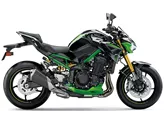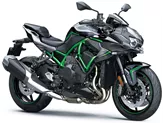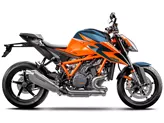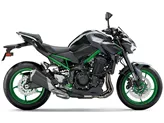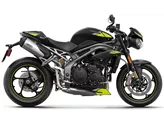Kawasaki Z1000 2014 vs. Kawasaki Z1000 R 2017

Kawasaki Z1000 2014

Kawasaki Z1000 R 2017
Visão geral - Kawasaki Z1000 2014 vs Kawasaki Z1000 R 2017
The Kawasaki Z1000 2014 and the Kawasaki Z1000 R 2017 are both inline-four naked bikes with identical engine specifications. They both have a liquid-cooled, 1043cc engine that produces 142 horsepower and 111 Nm of torque.
In terms of suspension, both models feature a telescopic fork with compression, preload, and rebound adjustments in the front, as well as compression, preload, and rebound adjustments in the rear. The chassis of both bikes is made of aluminum and has a double-cradle frame.

Kawasaki Z1000 2014
Both bikes also have dual disc brakes in the front with four-piston calipers, but the Z1000 R 2017 features radial monobloc petal technology, which provides superior braking performance compared to the Z1000 2014.
In terms of dimensions and weight, both bikes have the same tire widths and diameters, a wheelbase of 1435mm, and a seat height of 815mm. They also have the same curb weight of 221kg. However, the Z1000 R 2017 has a larger fuel tank capacity of 17 liters compared to the 15 liters of the Z1000 2014.
Now let's look at the strengths and weaknesses of each model. The Kawasaki Z1000 2014 has a sophisticated design, extremely pleasant handling, a pleasant sound, and good brakes. On the other hand, its main weakness is its high purchase price compared to the S1000R.

Kawasaki Z1000 R 2017
The Kawasaki Z1000 R 2017, on the other hand, has a powerful and potent naked bike engine. It offers pure power without any artificial or high-quality components. It also has a high-quality and superior chassis that provides stability, precision, and completeness. One of its advantages is that it offers a real naked bike feel without the fuss of a supersport. However, it has a limited steering angle and lacks a gear shift assistant.
In conclusion, while both the Kawasaki Z1000 2014 and the Kawasaki Z1000 R 2017 have similar technical specifications, the Z1000 R 2017 offers some improvements in terms of braking technology and fuel tank capacity. It also has a more powerful and potent engine, as well as a high-quality chassis. However, it does have some drawbacks such as a limited steering angle and the lack of a gear shift assistant.
Especificações técnicas Kawasaki Z1000 2014 em comparação com Kawasaki Z1000 R 2017
Prós e contras em comparação
Prós e contras em comparação
Kawasaki Z1000 2014

A Kawasaki Z1000 (2014) é uma afirmação contra a tendência eletrónica do seu tempo - e é exatamente isso que a torna especial hoje em dia. O seu caraterístico motor de quatro cilindros, a sua mecânica direta e o seu enfoque intransigente no essencial são um acorde numa época em que muitas motos se tornaram computadores. Sim, não tem os modernos Sistemas Avançados de Assistência ao Condutor e uma proteção perfeita contra o vento. Mas oferece uma experiência de condução autêntica de uma naked bike, aliada à fiabilidade japonesa e a custos de manutenção razoáveis. A Z1000 não é uma moto para viciados em folhas de dados ou fãs de eletrónica - é uma moto para pessoas que ainda querem tomar as suas próprias decisões quando conduzem. Uma moto honesta e com carácter que continua a inspirar mesmo após anos e que cumpre o seu papel como alternativa emocional à era moderna digital.
Kawasaki Z1000 R 2017

Claro que, no papel, a Z1000R é inferior às actuais Powernakeds e, numa avaliação clássica de pontos, também perde para a simplesmente perfeita Z900. MAS continua a exalar puro fascínio. Nem toda a gente vai gostar dela, mas alguns vão adorá-la. Uma moto verdadeiramente masculina com um motor muito superior e um chassis da era dourada das motos naked. A Z1000R continua a ser uma verdadeira naked bike da Supersport Gene - com todas as suas vantagens e desvantagens.
Comparação de preços Preço médio de mercado Kawasaki Z1000 vs Kawasaki Z1000 R
There are a few key differences between a Kawasaki Z1000 2014 and a Kawasaki Z1000 R 2017. In terms of price, the actual average price of a Kawasaki Z1000 R 2017 is about 73% higher. A Kawasaki Z1000 2014 experiences a loss of 810 EUR in one year and 610 EUR in two years of ownership. This is offset by a loss of 1 260 EUR and 4 410 EUR for a Kawasaki Z1000 R 2017. Compared to Kawasaki Z1000 R 2017 there are more Kawasaki Z1000 2014 bikes available on the 1000PS.de Marketplace, specifically 12 compared to 4. It takes less time to sell a Kawasaki Z1000 with 75 days compared to 173 days for a Kawasaki Z1000 R. Since model year 2005 1000PS.de editors have written 41 reviews for the Kawasaki Z1000 and 2 reviews for the Kawasaki Z1000 R since model year 2017. The first review for the Kawasaki Z1000 was published on 02/09/2002 and now has more than 5 800 views. This compares to more than 46 400 views for the first review on Kawasaki Z1000 R published on 02/06/2017.




